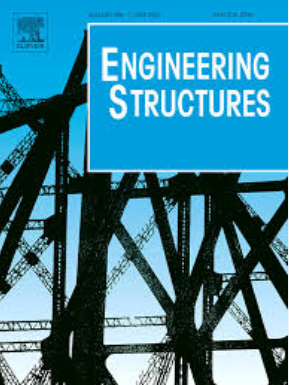A lightweight pendulum tuned mass inerter system for enhanced vibration control
IF 5.6
1区 工程技术
Q1 ENGINEERING, CIVIL
引用次数: 0
Abstract
Traditional tuned mass dampers (TMDs) have been effectively adopted in engineering structures owing to their reliable vibration control performance. Previous studies demonstrate that the apparent mass amplification effect of inerter devices can significantly reduce the required mass of TMDs while maintaining their vibration control effectiveness. However, this approach lacks an explicit experimental validation. Moreover, existing studies neglect the relationship between the physical implementation mechanisms of inerters and their lightweight control effects. To address these gaps, this study proposes a pendulum tuned mass inerter system (PTMIS), which incorporates an inerter with high apparent mass amplification into a conventional pendulum TMD. This achieves a lighter design without compromising the vibration control efficacy of the tuned-type device. A coupled dynamic model integrating the PTMIS with a single-degree-of-freedom primary system is developed to analyze the influence of the inerter’s apparent mass amplification factor on lightweight vibration control performance. A demand-oriented optimization framework is also introduced. The results indicate that inerter devices with low apparent mass amplification factors in the PTMIS do not sufficiently enable the lightweight control effect. Experimental results demonstrate that under comparable control objectives, PTMIS requires 39 % less tuned mass than a traditional TMD. A case study in a wind turbine application demonstrates that the PTMISs achieve comparable control efficacy to conventional TMDs while reducing the tuned mass by 10–26 % and the mass block displacement amplitude by an average of 17.3 %. This work validates the engineering feasibility of the PTMIS and provides an efficient lightweight vibration control solution for weight-sensitive structures by employing a so-called “replacing mass with inertia” paradigm.
一种用于增强振动控制的轻质摆调谐质量干涉系统
传统调谐质量阻尼器由于具有可靠的振动控制性能,在工程结构中得到了有效的应用。已有研究表明,干涉器的表观质量放大效应可以显著降低tmd所需质量,同时保持其振动控制效果。然而,这种方法缺乏明确的实验验证。此外,现有研究忽略了干涉器的物理实现机制与其轻量化控制效果之间的关系。为了解决这些问题,本研究提出了一种钟摆调谐质量干涉系统(PTMIS),该系统将具有高表观质量放大的干涉器集成到传统的钟摆TMD中。这实现了更轻的设计,而不影响调谐式装置的振动控制效果。建立了将该系统与单自由度主系统集成的耦合动力学模型,分析了惯性器表观质量放大系数对轻量化振动控制性能的影响。介绍了一种面向需求的优化框架。结果表明,在PTMIS中采用低表观质量放大因子的干涉器不能充分实现轻量化控制效果。实验结果表明,在相同的控制目标下,PTMIS所需的调谐质量比传统的TMD减少39% %。风力机应用实例研究表明,PTMISs的控制效果与传统tmd相当,可将调谐质量降低10 - 26% %,质量块位移幅度平均降低17.3% %。这项工作验证了PTMIS的工程可行性,并通过采用所谓的“用惯性代替质量”范式,为重量敏感结构提供了有效的轻量化振动控制解决方案。
本文章由计算机程序翻译,如有差异,请以英文原文为准。
求助全文
约1分钟内获得全文
求助全文
来源期刊

Engineering Structures
工程技术-工程:土木
CiteScore
10.20
自引率
14.50%
发文量
1385
审稿时长
67 days
期刊介绍:
Engineering Structures provides a forum for a broad blend of scientific and technical papers to reflect the evolving needs of the structural engineering and structural mechanics communities. Particularly welcome are contributions dealing with applications of structural engineering and mechanics principles in all areas of technology. The journal aspires to a broad and integrated coverage of the effects of dynamic loadings and of the modelling techniques whereby the structural response to these loadings may be computed.
The scope of Engineering Structures encompasses, but is not restricted to, the following areas: infrastructure engineering; earthquake engineering; structure-fluid-soil interaction; wind engineering; fire engineering; blast engineering; structural reliability/stability; life assessment/integrity; structural health monitoring; multi-hazard engineering; structural dynamics; optimization; expert systems; experimental modelling; performance-based design; multiscale analysis; value engineering.
Topics of interest include: tall buildings; innovative structures; environmentally responsive structures; bridges; stadiums; commercial and public buildings; transmission towers; television and telecommunication masts; foldable structures; cooling towers; plates and shells; suspension structures; protective structures; smart structures; nuclear reactors; dams; pressure vessels; pipelines; tunnels.
Engineering Structures also publishes review articles, short communications and discussions, book reviews, and a diary on international events related to any aspect of structural engineering.
 求助内容:
求助内容: 应助结果提醒方式:
应助结果提醒方式:


